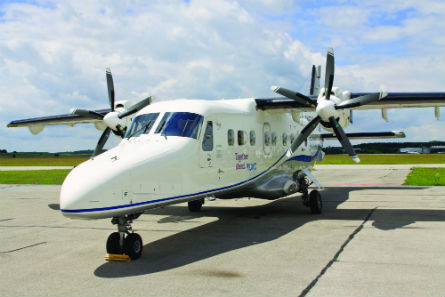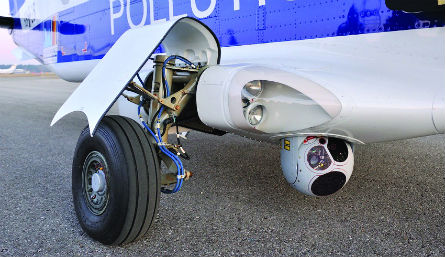In 2002, a major part of insolvent company Fairchild Dornier was acquired by Ruag, a Swiss group with divisions encompassing aviation, defence, space, munitions and technology. The result was a German commercial entity - Ruag Deutschland - based at Oberpfaffenhofen airfield, about 30km (19 miles) west of Munich. Ruag Deutschland was subdivided into Ruag Aerospace Structures - primarily supplying large airframe parts to Airbus - and Ruag Aerospace Services, covering German government military support as well as existing Dornier 228 civilian customer care support. Some 230 Do 228s are still flying, with 58 different customers worldwide, and Ruag holds the type certificate for the Do 228-212.
Based on this -212 type certificate, Ruag launched the Do 228 New Generation (NG) in 2007. It was certificated in 2010, under a European Aviation Safety Agency major-change approval. First delivery of the Do 228NG was in 2011 and eight have been sold to date, with customers including the Bangladeshi navy and the German coastguard. Ruag targets a production rate of eight to 12 Do 228NG aircraft per year to meet a forecast of 300-plus aircraft over 20 years. The complete airframe of the Do 228NG is built by India's Hindustan Aeronautics and shipped to Oberpfaffenhofen, where Ruag carries out final assembly and fits ancillary systems, engines and avionics.
ISTAR MARKET
Although the aircraft is available in corporate or commuter versions, seating up to 19 passengers, Ruag is aiming it at the intelligence, surveillance, targeting, acquisition and reconnaissance (ISTAR) market, in which it can serve as a special operations platform fitted with sideways-looking synthetic aperture radar, 360˚ search surveillance radar, electro-optical/infrared sensors, datalinks, a night-vision goggle-compatible cockpit, bubble-type observer/camera side windows and secure, encrypted communications.
Both long-range, broad-area and short-range, specific-target requirements can be met, with a variety of cabin layouts to accommodate up to five operators. The cabin can also be rapidly reconfigured for medevac, cargo or paratroop missions. The aircraft retains superb short take-off and landing capabilities, with a take-off run at maximum take-off weight of less than 700m (2,300ft) and a landing distance of 450m, plus the ability to operate from unprepared strips and in hot and high conditions. The Do 228NG retains the supercritical wing as the Do 228-212.
Ruag quotes €6.6 million ($8.3 million) for a passenger/commuter-configured Do 228NG. It is €2-3 million more for the ISTAR version, depending on the mission systems selected. A major part of the Do 228NG upgrade is the Universal UNS-1 digital glass cockpit with four 5x7in (13x18cm) multifunction displays (MFDs). As well as pilot flight, engine, and secondary aircraft information, the MFDs support precision GPS-based navigation overlaid with a terrain awareness warning system (TAWS), traffic collision and avoidance system (TCAS), electronic flightbag approach charts, weather radar, moving digital maps and electronic checklists.
Importantly, the UNS-1 system allows high-definition mission system sensor imagery to be displayed directly on any cockpit MFD without the need for additional mission-specific cockpit display screens, thereby keeping the cockpit uncluttered and the pilots directly in the loop with the mission system crew and their sensor usage/orientation. The upgrade also spans new MT five-blade propellers. Composite construction allows the blades to be smaller and lighter, to produce significantly less noise, and to boost reliability and safety margins through ability to handle power ratings well in excess of that which the Do 228NG's engines deliver.
 |
|---|
| Ruag The Do 228NG is powered by new Honeywell TPE331-10 turboprop engines |
The aircraft's new Honeywell TPE331-10 turboprop engines are derated from 940shp (700kW) to a flat-rated - up to international standard atmosphere plus 15˚C - 776shp.
The Do 228NG has a low-level top speed of 225kt (416km/h), a typical mission range of 1,300nm (2,400km), maximum take-off weight of 6,575kg (14,500lb), maximum landing weight of 6,400kg, and fuel burn of less than 200kg per hour when on station at 4,000ft (1,220m). At a typical mission point 200nm from base, it offers more than seven hours of mission endurance. Although it can be unpressurised if required, the Do 228NG can operate at up to 25,000ft with a supplemental crew oxygen system.
My test aircraft was the Ruag Do 228NG demonstrator, registered D-CNEU and flown from Oberpfaffenhofen in CAVOK weather - greater than 10km visibility, cloud above 5,000ft - and outside air temperature +25˚C. My safety pilot was Ruag Do 228NG project test pilot Franz Huber. Our planned take-off weight was 5,100kg and I took the left-hand seat to fly the complete sortie as a military pilot in a typical mix of SAR (very low level above ground) and ISTAR at medium levels - 4,000-10,000ft. I had never before flown any Do 228 version.
FIRST IMPRESSIONS
I was immediately struck by the length and size of the aircraft and impressed by three simple things: firstly, the front, left-hand pilot door allowed unimpeded entry/exit to the cockpit without having to negotiate through the cabin, an essential requirement for the aircraft in cargo role; secondly, the rear, left-hand passenger door folded out to form a passenger stairway, but the repositioning of only one external pin allowed the doors to hinge open as two parts of a clamshell, instantly converting a Do 228NG into a cargo version; and thirdly, the large, externally accessed baggage compartments at both the nose (120kg capacity) and tail (210kg capacity).
The cabin - with its square cross-section 7.08m in length, 1.55m in height and 1.35m in width - felt very roomy and, being air-conditioned, would provide an excellent operating environment for mission crew.
In the cockpit, the UNS-1 is conventional in operation and, like Honeywell and Rockwell Collins, uses two flight management system computer display units to input the majority of the pilot-required data. Screen definition of symbology on the MFDs was excellent. Once strapped in, I was again instantly impressed by the field of view especially to the side and down, with the mid-set high-wing, small engine nacelles causing no obscuration while the large window in the pilot door gave a feeling akin to that in a helicopter.
On the Beechcraft King Air 350, by comparison, the small front and side cockpit windows, large forward positioned engine nacelles and low forward set wing virtually eliminate the sideways- and downwards-looking fields of view so that lower fuselage cameras, set into a modified belly canoe, have to perform this role. It was clear to me, even before the start, that the Do 228NG was an excellent downwards-looking SAR/ISTAR platform which would allow aircrew to accurately position the aircraft over or alongside a target, even in basic visual or camera modes.
ENGINE DATA
Take-off, flap-1, gave V1/Vr/V2 speeds of 85/85/85kt. Take-off acceleration was very brisk and I estimated a take-off roll of around 450m with a rotate point about 10s after brake release. Cockpit engine indications were clear, although my suggestion would be to place an abbreviated set of engine data on the pilot flying display MFD so the engine instrument/crew alerting system MFD can be used for other mid-cockpit displays once the take-off phase or routine cruise checks are complete.
I levelled at 4,000ft and 180kt with the aircraft feeling exceptionally nimble. A roll through 90˚ from 45˚ angle of bank to the opposite 45˚ angle of bank took less than 2s and I estimate the steady state roll rate was about 70˚. Rapid rolls and roll reversals to high bank angles of up to 70˚ could be made not only easily and accurately, but the desired bank angle could be stopped at and held with absolute precision. Again, the sideways field of view inspired confidence in being able to visually clear into the turn while maintaining accurate height without reference to cockpit instruments. Spiral stability was completely neutral with no tendency for the aircraft to overbank into the turn if the pilot needs to relax on the yoke to carry out other tasks. Overall, the Do 228NG was exceptionally satisfying to fly, with excellent flight-control mechanical characteristics and very light control forces in all axes.
 |
|---|
| Ruag A 360˚ search surveillance is fitted |
At low level (250ft), over one of southern Bavaria's beautiful lakes, while at 130kt in a SAR type profile (clean), the fuel flow was 250/250lb/h. The aircraft was a pure joy to fly in this SAR regime.
At about 8,000ft, in an ISTAR profile (clean), with both engines set at 20/20% torque, the aircraft stabilised at a 120kt cruise and a fuel flow of 180/180lb/h. The aircraft felt stable, responsive and with very little adverse drag exhibited from the ailerons during hard manoeuvring at this level. Stall speed (clean) was about 60kt.
Recovering to Oberpfaffenhofen, level at an altitude of about 3,500ft, the aircraft accelerated rapidly and had to be throttled back to not exceed Vmo of 225kt, testament to the aircraft's excellent aerodynamics. A run in and break into the circuit was converted into a roller landing (flap-2) with a landing Vref of 81kt. This was followed by an ILS to runway 22. Input of ILS data and display of information on the MFDs was similar to Rockwell Collins or Honeywell but now with TCAS, TAWS and weather radar overlays, electronic flightbag and precision radio navigation aided by GPS.
This turns the Do 228NG into a 21st century airspace-capable aircraft while greatly improving the aircraft's survivability in austere navigation and high-terrain environments.
DIGITAL AUTOPILOT
Ruag are fitting the Do 228NG with a digital autopilot which has yet to be fitted to D-CNEU. I flew the ILS manually to 3.5nm maintaining 200kt. Placing the engines to idle torque and selecting gear (160kt limit) and flaps (flap-1: 160kt limit; flap-2 and flap-land: 130kt limit), in stages to land accurately at 79kt without having to reapply power prior to touchdown.
A short take-off was then flown flap-2 with V1/Vr/V2 at 75/75/82kt and with the aircraft rotated aggressively straight off the ground into an 18˚ climb. We then levelled in the visual circuit to fly a steep approach into short landing with flap-land selected for a Vapp of 85kt and a Vref of 79kt. I estimated the approach angle (held visually and with approach airspeed stable) to be about 9˚.
My short evaluation of the Do 228NG was a revelation. The aircraft's flyability in terms of handling and performance is simply superb; its usability - given its cabin cross-section and volume, the tactical roles it can perform and the massive suite of sensors it has been designed to carry plus integrate into a mission package - for this size of aircraft is both incredibly powerful and impressive. The new digital cockpit now completely transforms the aircraft's survivability.
The aircraft is not pressurised but it is just about everything else and I do not see pressurisation as a major disadvantage given that any SAR or environmental roles will be completed at low levels and most ISTAR roles can be fully covered below 10,000ft. For anything else, supplemental crew oxygen is a perfectly acceptable option.
Ruag looks to have chosen wisely in upgrading the Do 228 into a new-generation aircraft and, by designing it for civilian, corporate, government agency and military roles, the Do 228NG has the potential to become SAR and ISTAR aircraft of choice for many agencies worldwide.
Source: Flight International



















